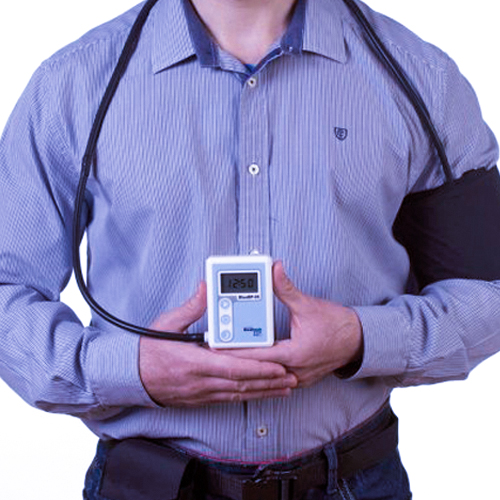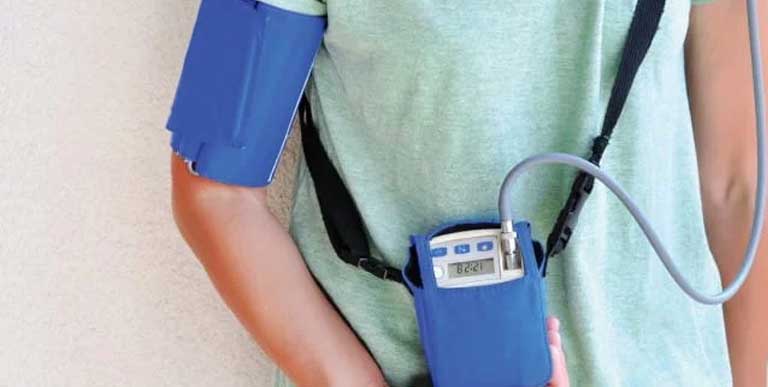The Benefits of the ABPM Test for Accurate Blood Pressure Evaluation
Ambulatory Blood Pressure Monitoring (ABPM) uses an innovative approach to reviewing high blood pressure. This approach supplies constant, 24-hour information, capturing variations that happen during everyday tasks and rest. Such in-depth monitoring not only boosts accuracy yet also exposes crucial patterns, assisting to identify between true hypertension and conditions like white-coat syndrome. Comprehending these subtleties could lead to more reliable therapy strategies. What implications might this have for individual treatment and management?
What Is Ambulatory Blood Pressure Monitoring (ABPM)?
Ambulatory Blood Pressure Monitoring (ABPM) is a method that allows for continuous blood stress assessment over a 24-hour period, supplying a substantial picture of a person's blood stress fluctuations. ABPM test in Bangalore. This strategy makes use of a mobile tool that immediately determines high blood pressure at normal intervals throughout the night and day. As individuals deal with their everyday tasks, the gadget captures information reflecting their high blood pressure variants during various times and conditions, consisting of rest and physical exertion.ABPM is especially useful for detecting conditions such as hypertension, as it can compare real high blood pressure and white-coat disorder, where people display elevated analyses in professional setups however not in their everyday lives. By providing an in-depth view of blood stress adjustments, ABPM aids medical care companies in making notified decisions relating to diagnosis and therapy. Furthermore, it enhances the understanding of high blood pressure patterns, allowing individualized management techniques for patients
Constant Monitoring for Improved Accuracy
Continuous monitoring of blood stress via ABPM considerably improves the precision of readings compared to traditional methods. This technique allows for high blood pressure dimensions at routine periods throughout the night and day, recording changes that may happen as a result of day-to-day tasks, anxiety, or other variables. Unlike single readings taken during a center see, ABPM offers an extensive profile of a person's blood pressure over a 24-hour period.This continual evaluation leads to extra reputable information, making it possible for doctor to recognize patterns and potential concerns that might go unnoticed with occasional dimensions. It also assists compare true hypertension and white-coat syndrome, where patients exhibit elevated readings because of stress and anxiety in a professional setting. By leveraging the benefits of continual monitoring, ABPM substantially enhances diagnosis and treatment techniques, ultimately adding to far better individual results and more customized health care strategies.
Recognizing Blood Pressure Irregularity
Blood pressure variability describes the variations in high blood pressure readings that can occur in time due to different factors, including physical activity, stress and anxiety, and circadian rhythms. This variability is significant as it supplies understandings right into a person's cardiovascular wellness. ABPM test in Bangalore. Factors such as exercise can momentarily enhance blood pressure, while relaxation may lead to a decline. Additionally, the body's natural rhythms can cause high blood pressure to vary throughout the day, usually being reduced during the night and higher during waking hours. High levels of variability have actually been related to boosted dangers of cardiovascular events, making it crucial for healthcare experts to check these changes. Recognizing high blood pressure irregularity aids in customizing therapy plans and reviewing overall health and wellness. Accurate appraisal via methods like Ambulatory High blood pressure Monitoring (ABPM) can catch these variants, enabling an extra thorough assessment of a person's high blood pressure profile
Identifying White Coat Hypertension
White coat high blood pressure, usually described as white layer disorder, is defined by elevated high blood pressure analyses in scientific settings due to stress and anxiety or stress. Recognizing its signs and signs is important for precise medical diagnosis, as misconception can result in unnecessary treatments. Comprehending this phenomenon is vital for effective high blood pressure management and patient treatment.
Recognizing White Coat Disorder
Many patients display elevated blood pressure analyses in clinical setups, this phenomenon, understood as white coat high blood pressure, can cover the true state of their cardiovascular wellness. This condition takes place when individuals experience anxiousness or tension during clinical brows through, leading to short-term spikes in blood pressure. Therefore, doctor may misinterpret these readings as a sign of high blood pressure. White layer syndrome highlights the significance of precise blood stress evaluation, as counting entirely on in-office measurements can cause unnecessary treatments or mistaken beliefs concerning a person's health. Recognizing this disorder is crucial for medical professionals, as it highlights the requirement for alternate monitoring approaches, such as ambulatory blood pressure monitoring (ABPM), to get a more exact representation of a client's see this here high blood pressure levels.
Signs and symptoms and Indicators
Many individuals may experience certain symptoms that suggest the presence of white layer high blood pressure. These signs can include elevated blood stress readings during medical visits, gone along with by feelings of anxiousness or anxiousness in a medical setting. Clients commonly report a fast heartbeat or sweating when engaging with health care specialists, which might intensify their blood stress levels. Additionally, some people might observe a difference in between their in-office high blood pressure analyses and those taken in your home, where they really feel a lot more unwinded. Recognizing these symptoms is vital, as they can show that anxiety or stress and anxiety pertaining to clinical settings is affecting their high blood pressure. Understanding these indicators can help in identifying white layer hypertension and determining the need for additional assessment.

Relevance of Accurate Diagnosis
Precisely diagnosing white coat hypertension is vital for effective blood stress management. This problem takes place when a patient shows elevated blood pressure readings in a clinical setting because of anxiety or stress and anxiety, while regular analyses are taped in a much more unwinded setting. Misdiagnosis can bring about unnecessary treatment, subjecting people to prospective medicine side results with no real health and wellness benefit. Using ambulatory high blood pressure monitoring (ABPM) is very important in identifying real high blood pressure from white coat disorder. ABPM gives continual high blood pressure measurements over 24-hour, enabling for a detailed assessment that can assist healthcare carriers make educated decisions. Ultimately, exact identification of white coat hypertension warranties patients obtain proper care and stays clear of the pitfalls of mismanagement.
Evaluating Nighttime Blood Pressure Patterns
Reviewing nighttime blood pressure patterns is crucial for comprehending a person's overall cardiovascular wellness. Nighttime measurements can view it now expose considerable changes in blood stress, which may show hypertension variability. In addition, these patterns are closely associated with heart health, highlighting the importance of continuous monitoring beyond common workplace visits.
Value of Nighttime Measurements

Nighttime high blood pressure measurements are usually crucial for comprehending an individual's total cardiovascular health and wellness. These readings give important insights right into exactly how high blood pressure acts throughout sleep, which can differ significantly from daytime degrees. Checking nighttime high blood pressure enables the recognition of abnormal patterns, such as non-dipping or reverse-dipping sensations, which might suggest an increased risk for cardio occasions. On top of that, nighttime evaluations can aid examine the performance of antihypertensive therapies, making certain that medications are suitably handled. By catching high blood pressure changes throughout the night, healthcare professionals can create more customized therapy plans, ultimately enhancing patient results and lowering the possibility of long-term difficulties related to high blood pressure. This emphasizes the significance of extensive blood stress evaluation throughout the day and evening.
Identifying Hypertension Irregularity
Just how can the irregularity of nighttime high blood pressure patterns inform high blood pressure management? The analysis of nighttime blood stress through the Ambulatory Blood Pressure Monitoring (ABPM) examination exposes essential changes that usually go unnoticed in traditional measurements. These patterns can show the visibility of "non-dipping" high blood pressure, where high blood pressure falls short to go down throughout sleep, suggesting a raised cardio danger. By recognizing such irregularity, health care service providers can tailor treatments more successfully, changing therapy plans based upon the person's certain nighttime high blood pressure behavior. Comprehending these patterns additionally aids in examining the efficacy of antihypertensive medicines, guaranteeing that patients attain perfect high blood pressure control throughout the night and day. As a result, nocturnal analysis becomes essential in thorough high blood pressure management.
Correlation With Heart Health
Comprehending nocturnal high blood pressure patterns not only help in high blood pressure administration yet additionally has considerable implications for heart wellness. Study suggests that irregular nighttime blood pressure analyses, such as non-dipping moved here or reverse dipping patterns, are related to increased cardiovascular risks. Throughout sleep, high blood pressure commonly decreases, a phenomenon crucial for cardiovascular healing. When this decrease is absent, it might signal underlying concerns such as free dysfunction or boosted arterial stiffness. Furthermore, people with elevated nighttime blood pressure go to an enhanced danger for heart assault and stroke. As a result, utilizing ambulatory blood pressure monitoring (ABPM) to evaluate these nighttime patterns can give crucial insights, enabling for tailored treatments that much better secure heart health and boost general person outcomes.
Tailoring Treatment Plans Based on Real-Life Data
Tailoring treatment plans based on real-life data includes leveraging continual high blood pressure monitoring to produce customized health care strategies. The Ambulatory Blood Pressure Monitoring (ABPM) test supplies a comprehensive profile of a client's high blood pressure variants throughout everyday tasks. This in-depth data enables health care carriers to determine patterns that may be forgotten in traditional office visits.By evaluating changes in high blood pressure throughout different times and conditions, clinicians can change medicines, does, and way of life suggestions to much better suit individual client requirements. This customized technique not just enhances the efficiency of treatment strategies but likewise reduces the possibility of adverse reactions to medications.Furthermore, real-life information can disclose potential triggers for high blood pressure, causing positive treatments. Generally, tailoring therapy based upon continuous monitoring cultivates a much more efficient, patient-centered method to taking care of hypertension and boosting long-lasting wellness outcomes.
Enhanced Patient Compliance and Involvement
While conventional monitoring approaches might restrict individual participation, the use of Ambulatory High blood pressure Monitoring (ABPM) considerably improves individual conformity and engagement in their own health care. By permitting patients to use a mobile device that records blood stress over 24 hours, ABPM equips people to take an energetic duty in their health monitoring. This continuous monitoring gives a more comprehensive view of high blood pressure changes, encouraging clients to comprehend their condition better.Moreover, ABPM cultivates an environment where clients can discuss their analyses with health care providers a lot more meaningfully, causing informed decision-making. Individuals end up being a lot more bought sticking to recommended therapies and way of living modifications when they see real-time information showing their wellness status. The change from easy participant to active partner not only boosts compliance however also enhances general health and wellness results, making ABPM an important tool in fostering individual interaction in high blood pressure monitoring.
Regularly Asked Concerns
How much time Does an ABPM Test Commonly Last?
The ABPM examination typically lasts 24 hr. During this duration, it gauges blood pressure at routine periods, offering a complete analysis of a patient's high blood pressure patterns throughout their daily activities and rest.
Exist Any Type Of Risks Connected With ABPM Testing?

Can ABPM Be Utilized for Children and Teens?
ABPM can be utilized for children and teens, offering important insights into their blood stress patterns. Appropriate tools sizing and analysis by skilled specialists are important to assure accurate analyses and stay clear of misdiagnosis.
How Is ABPM Different From Conventional Blood Pressure Monitoring?
ABPM differs from conventional monitoring by giving constant blood pressure readings over 1 day, recording variations during everyday activities and sleep, whereas conventional approaches frequently depend on single measurements, possibly missing critical variations in blood stress.
What Should Patients Do Throughout the ABPM Test?
During the ABPM examination, individuals must maintain typical activities while staying clear of hefty exercise, excessive high levels of caffeine, and smoking. They should also maintain their arm still when the tool blows up, making certain accurate analyses throughout the monitoring period.